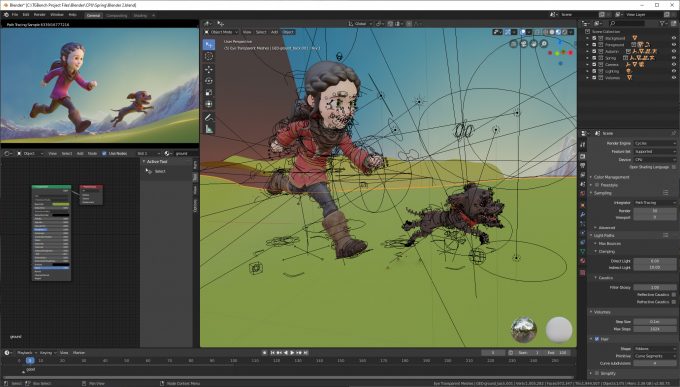Blender 2.80
By Max
With Blender 2.80 now launched, we’re taking a fresh look at performance across the latest hardware, including AMD’s latest Ryzen 3000-series CPUs and Navi GPUs, as well as NVIDIA SUPER cards. That includes both CPU and GPU testing with the Cycles renderer, GPU testing with Eevee, and viewport performance with LookDev.
Blender 2.80 CPU, GPU & Hybrid Rendering Performance

Since Blender 2.80 came out of beta a couple of weeks ago, we’ve been working on wrapping-up some performance testing with the help of a dozen or so CPUs and GPUs. As with our look at beta performance a few months ago, we want to find out what hardware gets the job done the quickest, and also figure out which hardware will offer the best value for the dollar overall.
Blender 2.80 might be a minor version bump over 2.79, but the reality is that this is such a massive update, it could have been called 3.0. From a performance perspective, what we care about for our testing is that the Cycles renderer has been given lots of polish, and the new GPU-focused Eevee renderer makes its debut. We will be testing both for our render tests here, in CPU-only, GPU-only, and hybrid tests.
Rendering is just part of the design equation, though. The vast majority of your time spent in Blender will involve staring at the viewport, the big box where all of the visual feedback takes place. The better the performance, the smoother models and scenes will spin. While Solid and Wireframe modes won’t prove too much of a problem for anyone, Blender 2.80’s new LookDev shading mode will make GPUs work hard. We’re taking a look at this performance on the next page
| CPUs & GPUs Tested in Blender 2.80 |
| AMD Ryzen Threadripper 2990WX (32-core; 3.0 GHz; $1,799) AMD Ryzen Threadripper 2970WX (24-core; 3.0 GHz; $1,299) AMD Ryzen Threadripper 2950X (16-core; 3.5 GHz; $899) AMD Ryzen Threadripper 2920X (12-core; 3.5 GHz; $649) AMD Ryzen 9 3900X (12-core; 3.8 GHz; $499) AMD Ryzen 7 3700X (8-core; 3.6 GHz; $329) AMD Ryzen 7 2700X (8-core; 3.7 GHz; $329) AMD Ryzen 5 3600X (6-core; 3.8 GHz; $249) AMD Ryzen 5 2600X (6-core; 3.6 GHz; $219) AMD Ryzen 5 3400G (4-core; 3.7 GHz; $149) Intel Core i9-9980XE (18-core; 3.0 GHz; $1,799) Intel Core i9-7900X (10-core; 3.3 GHz; $999) Intel Core i9-9900K (8-core; 3.6 GHz; $499) |
| AMD Radeon VII (16GB; $699) AMD Radeon RX 5700 XT (8GB; $399) AMD Radeon RX 5700 (8GB; $349) AMD Radeon RX Vega 64 (8GB; $EOL) AMD Radeon RX 590 (8GB; $279) AMD Radeon Pro WX 8200 (8GB; $999) NVIDIA TITAN RTX (24GB; $2,499) NVIDIA TITAN Xp (12GB; $1,200) NVIDIA GeForce RTX 2080 Ti (11GB; $1,199) NVIDIA GeForce RTX 2080 SUPER (8GB, $699) NVIDIA GeForce RTX 2070 SUPER (8GB; $499) NVIDIA GeForce RTX 2060 SUPER (6GB; $399) NVIDIA GeForce RTX 2060 (6GB; $349) NVIDIA GeForce GTX 1080 Ti (11GB; $EOL) NVIDIA GeForce GTX 1660 Ti (6GB; $279) NVIDIA Quadro RTX 4000 (8GB; $899) |
| All GPU-specific testing was conducted on our Intel Core i9-9980XE workstation. All product links in this table are affiliated, and support the website. |
| AMD Radeon Driver: Adrenaline 19.7.5 AMD Radeon Pro Driver: Enterprise 19.Q2.1 NVIDIA GeForce & TITAN Driver: GeForce 431.56 NVIDIA Quadro Driver: Quadro 431.02 |
Most major Blender releases come with a new scene that helps show off what the new version can do, and with 2.80 being as massive a release as it is, it truly warranted one. This time, the related project is called Spring, and its assets can be found for download here.
We had thought about adopting the scene in our testing, but the first 30 seconds or so of the render process is pre-processing that doesn’t use the CPU or GPU to any significant degree (it just bloats the end result time). Our current projects will still portray accurate scaling with either Cycles or Eevee, but it would have been nice to adopt the latest official project.
When we tackled 2.80 beta performance months ago, we used many more GPUs and CPUs than have been used here, largely because most of the models end up just being noise, and not very helpful. This is especially true when many workstation and gaming cards are counterparts, and overlap in performance (but not always feature sets). We’re keeping it simpler here. For CPUs, we wanted to get the Intel Core i7-8700K in, but our Intel Z390 motherboard died before we could get to it.
If after reading, you are still not sure about what hardware you should go with, please feel free to leave a comment. In time, we hope to add an animation-type test to Blender, as well as NVIDIA RTX-related tests. RTX features were announced a couple of weeks ago at SIGGRAPH, but are not currently included in the stable build. We’ll explore testing that soon, but for now, it’s not relevant to the current Blender.
CPU Rendering
At least with our chosen projects, we’ve found that faster GPUs will prove more beneficial than faster CPUs, but having fast of both is going to produce even better rewards. If the only thing you ever do on your PC is work in Blender, you may not need to splurge on a high-end CPU; otherwise, you’ll want to take other workloads into consideration when choosing a new CPU.
Comentários
Postar um comentário